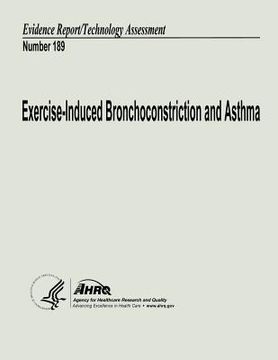Exercise-Induced Bronchoconstriction and Asthma: Evidence Report/Technology Assessment Number 189
Synopsis "Exercise-Induced Bronchoconstriction and Asthma: Evidence Report/Technology Assessment Number 189"
Vigorous physical exercise can be followed by transient clinical signs and symptoms similar to an asthma attack and are due to post-exercise bronchoconstriction (i.e., a narrowing of the airways). Clinical symptoms include coughing, wheezing, shortness of breath, excessive mucus production, chest tightness, chest pain, or an 'itching or scratching sensation' in the chest. Though it is more common in people with asthma, it also occurs in people without asthma. For the purposes of this evidence report, we defined exercise-induced bronchoconstriction (EIB) as "the airway obstruction that occurs in association with exercise without regard to the presence of chronic asthma" and we defined exercise-induced asthma (EIA) as "the condition in which exercise induces symptoms of asthma in patients who have asthma." Research is ongoing to determine if the pathogenesis of the phenomenon is the same in non-asthmatics and asthmatics. In this report EIB and EIA were analyzed and discussed separately when the populations and data were specifically identified by authors of the primary studies as one or the other. When it was not clear or studies included patients with and without asthma, we referred to them as EIB/EIA. The objective of this report was to synthesize the evidence for six key questions on diagnostic test accuracy for EIB/EIA and six key questions on therapy for EIB/EIA. D-1. In patients with suspected EIB/EIA, what are the diagnostic test characteristics of a self-reported history/symptoms diary for diagnosing EIB/EIA compared with a standardized exercise challenge? D-2. In patients with suspected EIB/EIA, what are the diagnostic test characteristics of a methacholine challenge (MCH) for diagnosing EIB/EIA compared with a standardized exercise challenge? D-3. In patients with suspected EIB/EIA, what are the diagnostic test characteristics of sport/venue specific exercise challenges for diagnosing EIB/EIA compared with a standardized exercise challenge? D-4. In patients with suspected EIB/EIA, what are the diagnostic test characteristics of eucapnic voluntary hyperpnea (EVH) for diagnosing EIB/EIA compared with a standardized exercise challenge? D-5. In patients with suspected EIB/EIA, what are the diagnostic test characteristics of a free running asthma screening test (FRAST) for diagnosing EIB/EIA compared with a standardized exercise challenge? D-6. In patients with suspected EIB/EIA, what are the diagnostic test characteristics of mannitol for diagnosing EIB/EIA compared with a standardized exercise challenge? T-1. In patients with confirmed EIB/EIA, do patients using short- or long-acting beta-agonists (SABA or LABA) therapy develop tachyphylaxis to treatment and, if so, at what frequency, compared with standard comparator treatments and/or placebo? T-2. In patients with confirmed EIB/EIA, does pre-exercise treatment with leukotriene receptor antagonist therapy (LTRA) reduce symptoms and prevent a 10 percent or more drop in FEV compared with no treatment/placebo? T-3. In patients with confirmed EIB/EIA, does pre-exercise treatment with inhaled corticosteroid therapy (ICS) reduce symptoms and prevent a 10 percent or more drop in FEV compared with no treatment/placebo? T-4. In patients with confirmed EIB/EIA, does pre-exercise treatment with mast cell stabilizers (sodium cromoglycate or nedocromil; MCS) therapy reduce symptoms and prevent a 10 percent or more drop in FEV1 compared with no treatment/placebo? T-5. In patients with confirmed EIB/EIA, does pre-exercise treatment with anticholinergic therapy (SAAC) reduce symptoms and prevent a 10 percent or more drop in FEV1 compared with no treatment/placebo? T-6. In patients with confirmed EIB/EIA, does a refractory period (10 to 15 minute warmup and/or cooldown) reduce symptoms and prevent a 10 percent or more drop in FEV compared with no treatment/placebo?

